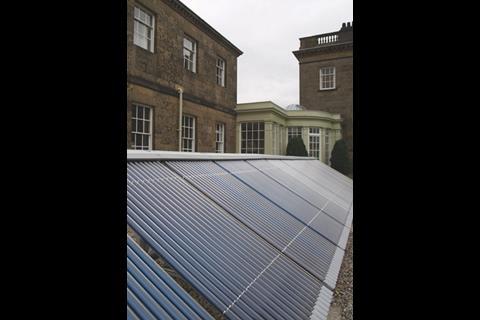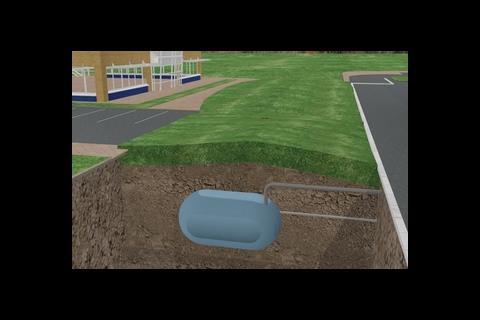Older stock must perform more efficiently if the government is to have any chance of meeting its carbon reduction targets. Even listed buildings can adapt well to some sustainable services technology.
A sustainable refurbishment will increase a building’s asset value and rental yield by making it appeal to more clients. And, in light of rising energy prices, it also offers the best opportunity to ensure that a building performs more efficiently throughout its life, reducing the client’s energy costs and maintenance requirements.
As the deadlines for the government’s sustainability targets draw near, more legislation is likely to be issued. By taking this into account now, clients can ensure their buildings are ahead of the game.
But there are significant challenges to be overcome in the planning stages of a sustainable refurbishment. For example, working within an old structure means flexibility is very limited. The absence of raised floors and suspended ceilings makes the routing of ducts, pipes and wires extremely difficult.
New technologies do help us to overcome some of the limitations. Wireless services overcome the issue of concrete walls and solid floors and ceilings. Nanotechnologies also help with these types of projects – smaller equipment is much easier to incorporate in confined spaces.
Open protocols, such as iBEMS, mean all the services in a building can be controlled by an integrated system to reduce carbon emissions and constantly refine their performance. For example, data can show the routine behaviour of occupants, so in linking to their calendars it is possible to adjust services such as heating where they are scheduled to be absent, reducing unnecessary energy consumption. However, advanced technologies such as these are still relatively expensive so they are harder to justify in difficult economic times.
Site limitations
Other sustainable technologies, such as ground source heat pumps, are difficult to install within what are likely to be tight site boundaries – or the building location may be inappropriate in some other way. What’s more, the limited access to most refurbishment sites means off-site construction is not a practical option – you can’t get large, preassembled modules through doorways.
Generally, there is also a lack of storage space which means it is necessary to adopt just in time (JIT) delivery whereby all the necessary components are delivered separately by different suppliers, as and when they are needed. The environmental impact of this is far from ideal, as there is a constant stream of vehicles delivering to the site which has implications in terms of carbon emissions as well as disruption of the surrounding area.
This also involves the use of more boxes and packaging for component parts, which creates more waste and therefore more waste collections, adding to site traffic. Inconvenience on site is increased too; access may be blocked by delivery vehicles for lengthy periods while components are unloaded. All of these tasks are labour intensive, taking additional time and manpower.
Involvement of specialists during the planning stages will minimise the limitations of older buildings for sustainable refurbishment
The environmental impact of JIT delivery can be overcome by working with the supply chain to develop innovative solutions for waste management and delivery schedules. An example of this is the room kits NG Bailey is using in its work on the listed Berners Hotel in London. This involves multiple suppliers and subcontractors collaborating to assemble as many as possible of the required components off-site, before delivery as one unit.
There are a number of more easily applied methods that are ideal for use in sustainable refurbishments. Using the roof space for a solar power installation is a relatively simple addition as there aren’t as many limitations from the building’s structure. In NG Bailey’s refurbishment of its own head office, Denton Hall in Yorkshire, solar panels have been installed in the gardens to provide water heating.
Another sustainable technique used at Denton Hall is rainwater harvesting. The large roof space provides a good catchment area where significant quantities of water can be collected and stored in tanks.
Photovoltaic glass (PVG) is an energy efficient technology that is applicable to most sustainable refurbishments; however it can be more difficult when working with listed developments if window areas are protected. PVG contains integrated solar cells that convert solar energy into electricity. The solar cells are embedded between two glass panes and generate a direct electrical current, meaning a large amount of power can be produced from the glazed areas of the building’s surface. But it is relatively expensive, which could raise issues in a tight financial climate.
Client resistance
Despite the obvious benefits, there is limited demand for sustainable refurbishments, in comparison with the interest in developing sustainable new-builds. This is not only because of the restrictions surrounding them, but also the reality that speed is quite often the main priority for clients. They want to get buildings back in business as soon as possible and incorporating sustainable measures is perceived to create unnecessary delay.
It is also uncommon for a client to take a holistic approach to the building, particularly if only part of it is being refurbished. The whole- life costs may not even have been considered as a factor in the design of the project.
However, the demand for measures to improve buildings’ performance is likely to increase in line with legislation as we move closer to the government’s sustainability target deadlines.
Even with the range of innovative technologies that can be successfully implemented in refurbishment projects, existing buildings will always present limitations that can only be minimised by early involvement of sustainability specialists during planning stages.
Source
Building Sustainable Design
Postscript
Peter Capel is project manager with NG Bailey

























No comments yet